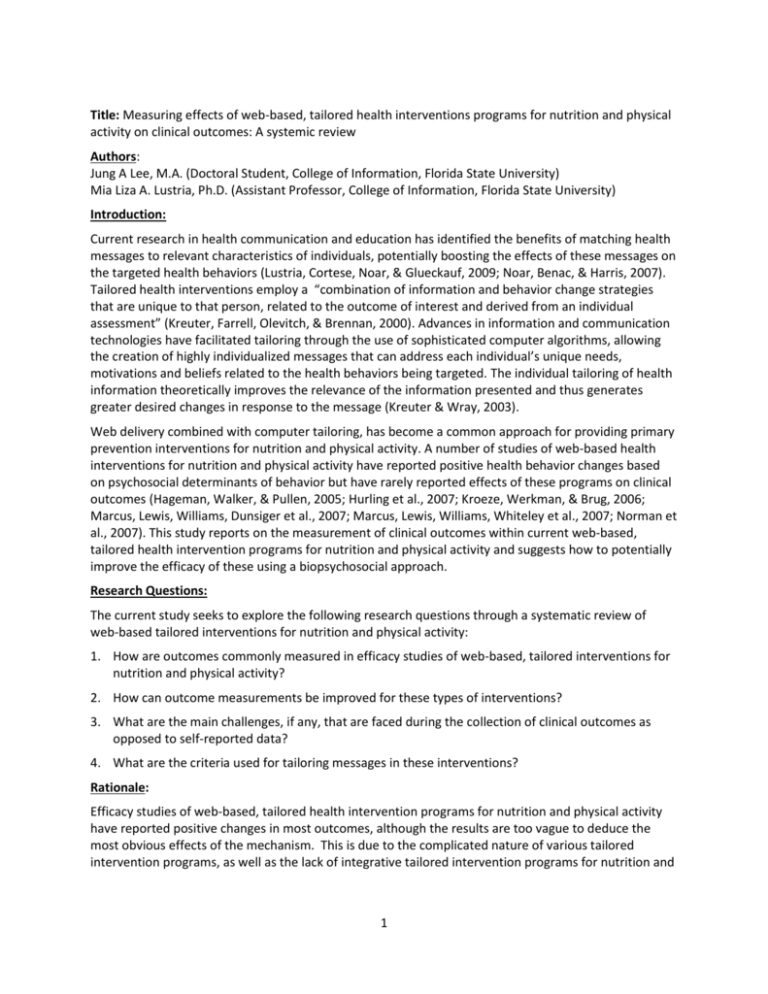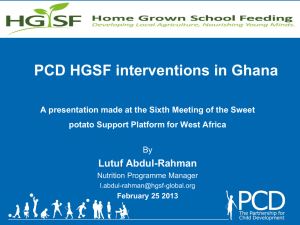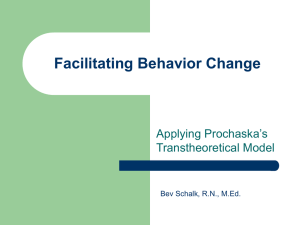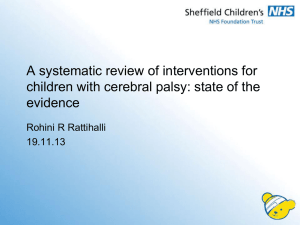Title: Measuring effects of web-based, tailored health interventions
advertisement

Title: Measuring effects of web-based, tailored health interventions programs for nutrition and physical activity on clinical outcomes: A systemic review Authors: Jung A Lee, M.A. (Doctoral Student, College of Information, Florida State University) Mia Liza A. Lustria, Ph.D. (Assistant Professor, College of Information, Florida State University) Introduction: Current research in health communication and education has identified the benefits of matching health messages to relevant characteristics of individuals, potentially boosting the effects of these messages on the targeted health behaviors (Lustria, Cortese, Noar, & Glueckauf, 2009; Noar, Benac, & Harris, 2007). Tailored health interventions employ a “combination of information and behavior change strategies that are unique to that person, related to the outcome of interest and derived from an individual assessment” (Kreuter, Farrell, Olevitch, & Brennan, 2000). Advances in information and communication technologies have facilitated tailoring through the use of sophisticated computer algorithms, allowing the creation of highly individualized messages that can address each individual’s unique needs, motivations and beliefs related to the health behaviors being targeted. The individual tailoring of health information theoretically improves the relevance of the information presented and thus generates greater desired changes in response to the message (Kreuter & Wray, 2003). Web delivery combined with computer tailoring, has become a common approach for providing primary prevention interventions for nutrition and physical activity. A number of studies of web-based health interventions for nutrition and physical activity have reported positive health behavior changes based on psychosocial determinants of behavior but have rarely reported effects of these programs on clinical outcomes (Hageman, Walker, & Pullen, 2005; Hurling et al., 2007; Kroeze, Werkman, & Brug, 2006; Marcus, Lewis, Williams, Dunsiger et al., 2007; Marcus, Lewis, Williams, Whiteley et al., 2007; Norman et al., 2007). This study reports on the measurement of clinical outcomes within current web-based, tailored health intervention programs for nutrition and physical activity and suggests how to potentially improve the efficacy of these using a biopsychosocial approach. Research Questions: The current study seeks to explore the following research questions through a systematic review of web-based tailored interventions for nutrition and physical activity: 1. How are outcomes commonly measured in efficacy studies of web-based, tailored interventions for nutrition and physical activity? 2. How can outcome measurements be improved for these types of interventions? 3. What are the main challenges, if any, that are faced during the collection of clinical outcomes as opposed to self-reported data? 4. What are the criteria used for tailoring messages in these interventions? Rationale: Efficacy studies of web-based, tailored health intervention programs for nutrition and physical activity have reported positive changes in most outcomes, although the results are too vague to deduce the most obvious effects of the mechanism. This is due to the complicated nature of various tailored intervention programs, as well as the lack of integrative tailored intervention programs for nutrition and 1 physical activity. Research concerning the effects of web-based, tailored interventions need to employ more objective clinical outcomes to provide better evidence for the efficacy of such programs. Method: We conducted an extensive search for web-based, tailored health intervention studies for nutrition and physical activity published in English-language peer-reviewed journals from 1996 to 2009. Two scholarly databases (Medline and ERIC) were searched using the following main terms in various combinations: ‘Internet’, ‘Web‘, ‘health intervention’, and ‘tailoring’. The main search terms were selected based on their high recall ratio (or ability to retrieve relevant articles). Secondary search terms that also yielded relevant citations were: ‘health education’, ‘behavior change programs’, and ‘computer tailoring’. The initial search yielded thousands of citations – 120 of these were potentially relevant studies and were archived in an Endnote (ver. 10) database. Studies were screened in several stages using explicit inclusion and exclusion criteria. First, the citations were reviewed to judge their general eligibility for the systematic review (e.g., behavioral change interventions related to physical activity or nutrition, with web component, focused on patient population, used computer tailoring, evaluated through a randomized controlled trial or quasiexperimental study). The citations were evaluated and generally ineligible studies (i.e., studies that did not include a behavior change component; studies about online health information seeking, telemedicine, and web-based continuing medical education) were excluded. Abstracts were further evaluated and studies that were not randomized controlled trials (RCTs) or quasi-experimental studies, did not have a web component, and/or did not incorporate any tailoring also were excluded. ‘Computer tailoring’ was operationally defined as the use of automated methods for collecting, assessing and providing individualized feedback to patients. Since we were interested in coding and comparing studies on a wide range of characteristics, comprehensiveness of reporting was also a key consideration in selection of articles. This second step yielded a total of 13 potentially eligible studies. Full-text copies of the remaining 13 potentially relevant studies were examined more closely to confirm whether computer-tailoring was used in the intervention and to examine more closely the measurement of outcomes. Nine studies were accepted to create the normalized data, from baseline results to post results, for the cardiovascular risk file, e.g. body mass index (BMI), physical activity, body fat, diastolic blood pressure (DBP), and high density lipid (HDL). 2 Potential relevant studies screened for retrieval n=120 Studies excluded: No web, no tailored, not RCT, not behavioral, not reported outcome (baseline & post) (n=107) Studies for systemic review n=13 Studies excluded: Had incomplete reports of outcomes (baseline & post), outliers (n=4) Studies for normalized rate n=9 Results: About 120 studies from the first screening were identified, of this, 13 studies fit the inclusion criteria, 4 of which were later excluded upon closer examination. We found that current efficacy studies of webbased, tailored health intervention programs for nutrition and physical activity were more likely to focus on health behavior change rather than on improvements in actual clinical outcomes. As a matter of fact, most outcome measurements were dependent upon the self-reporting of data. This potentially leads to outcomes with missing or irrelevant data. This downside reflects the limitations of the online environment for measuring outcomes based on more objective clinical data. It also demonstrates the difficulty of collecting treatment outcomes in real and actual settings, rather than by research assistants in controlled environments. Despite these limitations, a small number of studies have been able to produce positive results in some clinical outcomes such as cardiovascular risk profiles including blood pressure, cholesterol level, and BMI. In particular, 9 trials of web-based, tailored health intervention programs for nutrition and physical activity revealed positive treatment effects of tailored interventions on BMI, physical activity, body fat, DBP, and HDL. The normalized data from this small set of studies provide positive feedback regarding the potential effectiveness of web-based tailored health behavior interventions on actual clinical outcomes. 3 Figure 1. Normalized data from systematic review. Limitations: Due to the heterogeneous and limited outcomes of web-based, health tailored interventions, for nutrition and physical activity, the sample sizes were too small to confirm any statistical significance. Conclusion: Recently, web-based, tailored intervention programs have been developed as innovative tools to improve health behaviors. These programs believe that the tailored messages provided can lead to changes in individual health behaviors and that the latter, in turn, can translate into positive clinical outcomes such as reduced body fat, increased HDL levels and decreased weight, as examples. However, the limited measurement of clinical outcomes in most studies constrain our ability to make generalizations about the effectiveness of web-based, tailored intervention programs. Moreover, criteria used for tailoring messages in programs often rely on psychosocial determinants of behavior. We submit that a more accurate profile of patients can be attained through the assessment of individual, physiological and clinical conditions as a basis for tailoring. Lastly, to create an accessible and measurable standard for the efficacy of web-based, tailored intervention programs, clinical outcomes, such as cardiovascular risk profiles including blood pressure, cholesterol level, and body mass index, should be taken into consideration. Thus, the design of these web-based intervention programs must 4 build in mechanisms for measuring health indicators such as BMI, total cholesterol, and waist-to-hip ratio, which can be used as more accurate measures of intervention efficacy. REFERENCES Hageman, P. A., Walker, S. N., & Pullen, C. H. (2005). Tailored versus standard internet-delivered interventions to promote physical activity in older women. Journal of Geriatric Physical Therapy, 28(1), 28-33. Hurling, R., Catt, M., Boni, M. D., Fairley, B. W., Hurst, T., Murray, P., et al. (2007). Using internet and mobile phone technology to deliver an automated physical activity program: randomized controlled trial. J Med Internet Res, 9(2), e7. Kreuter, M. W., Farrell, D., Olevitch, L., & Brennan, L. (2000). Tailoring health messages: Customizing communication with computer technology Mahwah, N.J.: Lawrence Erlbaum Associates. Kreuter, M. W., & Wray, R. J. (2003). Tailored and targeted health communication: strategies for enhancing information relevance. Am J Health Behav, 27 Suppl 3, S227-232. Kroeze, W., Werkman, A., & Brug, J. (2006). A systematic review of randomized trials on the effectiveness of computer-tailored education on physical activity and dietary behaviors. Annals of Behavioral Medicine, 31(3), 205-223. Lustria, M. L. A., Cortese, J., Noar, S. M., & Glueckauf, R. L. (2009). Computer-tailored health interventions delivered over the web: Review and analysis of key components. Patient Education and Counseling, 74(2), 156-173. Marcus, B. H., Lewis, B. A., Williams, D. M., Dunsiger, S., Jakicic, J. M., Whiteley, J. A., et al. (2007). A comparison of Internet and print-based physical activity interventions. Arch Intern Med, 167(9), 944-949. Marcus, B. H., Lewis, B. A., Williams, D. M., Whiteley, J. A., Albrecht, A. E., Jakicic, J. M., et al. (2007). Step into Motion: a randomized trial examining the relative efficacy of Internet vs. print-based physical activity interventions. Contemp Clin Trials, 28(6), 737-747. Noar, S. M., Benac, C. N., & Harris, M. S. (2007). Does tailoring matter? Meta-analytic review of tailored print health behavior change interventions. Psychological Bulletin, 133(4), 673-693. Norman, G. J., Zabinski, M. F., Adams, M. A., Rosenberg, D. E., Yaroch, A. L., & Atienza, A. A. (2007). A review of eHealth interventions for physical activity and dietary behavior change. Am J Prev Med, 33(4), 336-345. 5








